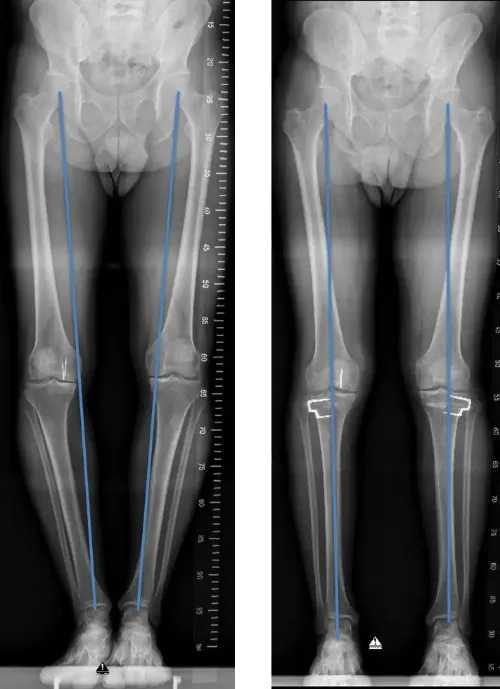Knee Osteotomy
"A successful osteotomy can delay the need for joint replacement with a prosthesis for several years".
DR. ANDRÉS VALENTÍ AZCÁRATE SPECIALIST. ORTHOPEDIC SURGERY AND TRAUMATOLOGY DEPARTMENT

What is an osteotomy?
Osteotomy literally means "cutting the bone". In a knee osteotomy, a "fracture" of the tibia or femur is performed in a controlled manner and stabilized in its new position to relieve pressure, load, correct a deviation from the normal axis (deaxation) and reduce pain over the knee joint.
Knee osteotomy is used when a patient has early stage osteoarthritis that has damaged only one side of the knee joint.
Osteotomy, by changing and decreasing the weight of the damaged side of the joint, can relieve pain and significantly improve function in an impaired knee.
Because the results of knee prostheses have been so successful, knee osteotomy has become less common. However, it remains an excellent option for many young, active patients where the prosthesis would limit their activities and natural perception of their knee.

When is knee osteotomy indicated?
Knee osteotomy is an effective procedure and has three objectives:
- To transfer the weight of the worn part of the knee to a healthier area.
- To correct the misalignment of the knee, to avoid the continuous progression of the wear.
- Prolong the life of your natural knee joint.
As ideal indication of the osteotomy of knee they are patients with a suitable weight, active, male of less than 60 years or women of less than 55 years and with pain in a single side of the knee.
Knee pain should be mainly caused by activity, as well as by standing for a long period of time.
Candidates should be able to almost fully stretch the knee and bend it at least 90 degrees.

Medial knee impingement
Do you have this problem?
You may need to have a knee osteotomy
Advantages and disadvantages of knee osteotomy
Advantages of Knee Osteotomy
One of the great advantages of the procedure is that, by preserving your own knee anatomy, a successful osteotomy can delay the need for a joint replacement by a prosthesis for several years.
This osteoarthritis will not be stopped 100%, but we will manage to gain years of active life.
Another advantage is that there are no restrictions on physical activities after an osteotomy: you will be able to participate in your previous activities with the appropriate recommendations, even in high-impact exercises.
Disadvantages of Knee Osteotomy
Osteotomy also has disadvantages. For example, pain relief is not as predictable after the osteotomy compared to a partial or total knee replacement.
The recovery process from the osteotomy is often more tedious and difficult initially because you may not be able to put weight on the operated knee immediately (4-6 weeks) or your mobility may be limited.
How is a knee osteotomy performed?

Realización de la osteotomía de rodilla
Most osteotomies for osteoarthritis of the knee are performed on the tibia to correct an arched leg alignment that places too much stress on the inside of the knee.
High Tibial Osteotomy (HTO)
During this procedure, a wedge of bone is removed from the outside of the tibia, straightening the leg (closure osteotomy). As a result, the knee can carry weight more evenly, relieving pressure on the painful side. This same correction can be made by opening a bone wedge on the inside of the knee and adding a bone wedge if required (opening osteotomy).
Your surgeon will discuss with you the most appropriate procedure.
Femoral osteotomies are performed using the same technique. They are usually done to correct a "valgus" alignment.
Complicaciones de la osteotomía
As with any surgical procedure, there are risks associated with osteotomy. Your surgeon will discuss each of the risks with you and take specific steps to help avoid potential complications.
Although the risks are low, the most common complications include: infection, thrombosis, stiffness of the knee joint, injury to vessels and nerves, and lack of bone healing, especially in smokers.
Recuperación tras la osteotomía
In most cases, patients go home within 1-2 days after an osteotomy. After surgery, you will feel some pain, but your surgeon and nurses will do everything possible to help you feel as comfortable as possible. There are many types of pain medications available to help control pain.
After surgery, your surgeon will tell you how much weight you can carry on your limb, when you can begin rehabilitation, when you will need to be treated, and will give you a date for follow-up x-rays and clinical tests.
You may be able to resume full activity three to six months after surgery.
Discharge
For most patients, osteotomy is successful in relieving pain and slowing the progression of osteoarthritis in the knee. It can allow a young patient to lead a more active lifestyle for many years.
Although many patients will eventually require a total knee replacement, an osteotomy can be an effective way to gain time until a prosthesis is required.
Implante adaptado para la osteotomía de rodilla
Se diseña de forma personalizada para la rodilla de cada paciente, permitiendo adecuarse al grado de corrección que precisa la articulación.
Where do we do it?
IN NAVARRA AND MADRID
The Department of Orthopedic Surgery and Traumatology
of the Clínica Universidad de Navarra
The Department of Orthopedic Surgery and Traumatology covers the full spectrum of congenital or acquired conditions of the musculoskeletal system including trauma and its aftermath.
Since 1986, the Clinica Universidad de Navarra has had an excellent bank of osteotendinous tissue for bone grafting and offers the best therapeutic alternatives.
Organized in care units
- Hip and knee.
- Spine.
- Upper extremity.
- Pediatric orthopedics.
- Ankle and foot.
- Musculoskeletal tumors.

Why at the Clinica?
- Experts in arthroscopic surgery.
- Highly qualified professionals who perform pioneering techniques to solve traumatological injuries.
- One of the centers with the most experience in bone tumors.




















